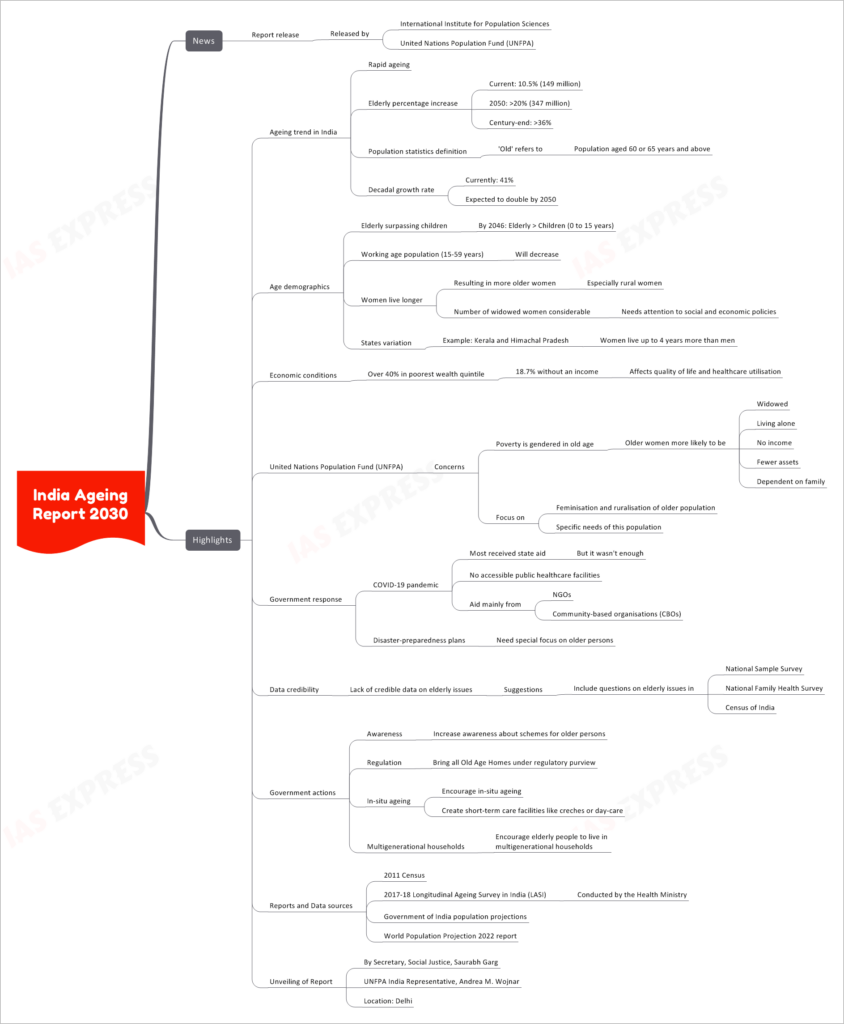India Ageing Report 2030

The recently unveiled “India Ageing Report 2030” sheds light on the rapidly evolving demographic landscape of India. This comprehensive report was jointly released by the International Institute for Population Sciences and the United Nations Population Fund (UNFPA).
This topic of “India Ageing Report 2030” is important from the perspective of the UPSC IAS Examination, which falls under General Studies Portion.
Ageing Trends in India: A Glimpse into the Future
Rapid Ageing
India is experiencing a swift transition towards an ageing population, with the elderly segment growing at an unprecedented rate.
Elderly Population Surge
- Current: The report indicates that the elderly population currently stands at 10.5%, comprising 149 million individuals.
- 2050 Projection: By 2050, this demographic is expected to swell to over 20%, accounting for a staggering 347 million people.
- Century-End: The report forecasts that by the end of this century, the elderly population will exceed 36% of India’s total population.
Defining ‘Old’
In the context of this report, individuals aged 60 or 65 years and above are considered ‘old’.
Accelerated Decadal Growth Rate
The decadal growth rate of the elderly population, currently at 41%, is anticipated to double by 2050.
Age Demographics: Shifting Balances
Elderly Surpassing Children
A significant demographic milestone is projected: by 2046, the elderly population is expected to surpass the number of children (0 to 15 years).
Declining Working-Age Population
The working-age population (15-59 years) is set to decrease, posing potential challenges for the labor force and economic productivity.
Gender Disparities
- Women’s Longevity: Women tend to live longer, resulting in a larger proportion of older women.
- Rural Women: This trend is especially pronounced among rural women.
- Widowed Women: The report highlights a considerable number of widowed women, necessitating focused attention from social and economic policies.
State Variations
States like Kerala and Himachal Pradesh stand out, where women tend to live up to four years longer than men, accentuating regional disparities.
Economic Conditions: A Glimpse into Inequality
- Poverty Rates: Over 40% of the elderly population falls within the poorest wealth quintile.
- Income Disparity: Nearly 18.7% of elderly individuals have no source of income, significantly impacting their quality of life and access to healthcare.
UNFPA Concerns and Government Response
UNFPA Concerns
The UNFPA expresses concerns about the gendered nature of poverty among older individuals. Older women are more likely to be widowed, live alone, have no income, possess fewer assets, and depend on family support.
Government Response
COVID-19 Pandemic
- While most older persons received state aid during the COVID-19 pandemic, it was often insufficient.
- Accessible public healthcare facilities for the elderly remain lacking, and aid primarily came from NGOs and community-based organizations (CBOs).
Disaster-Preparedness Plans
Special attention is required in disaster-preparedness plans to cater to the needs of older persons.
Data Credibility and Government Actions
Data Credibility
The report highlights a lack of credible data on elderly issues and suggests including relevant questions in national surveys like the National Sample Survey, National Family Health Survey, and Census of India.
Government Actions
- Awareness: The government should enhance awareness of schemes for older persons.
- Regulation: All Old Age Homes should be brought under regulatory purview.
- In-situ Ageing: Encouraging in-situ ageing and creating short-term care facilities like creches or day-care centers.
- Multigenerational Households: Promoting the concept of elderly people living in multigenerational households.
Reports and Data Sources
The report draws on various sources, including the 2011 Census, the 2017-18 Longitudinal Ageing Survey in India (LASI) conducted by the Health Ministry, Government of India population projections, and the World Population Projection 2022 report.
Unveiling of Report
The report was officially unveiled in Delhi by Secretary of Social Justice, Saurabh Garg, and UNFPA India Representative, Andrea M. Wojnar, marking a significant step in understanding and addressing India’s ageing population challenges.

